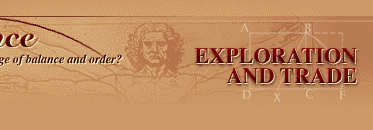  |
 Tools developed in the Middle Ages for exploration continued to be used during the Renaissance. One of these was the astrolabe, a portable device used by sailors to help them find their way. By measuring the distance of the sun and stars above the horizon, the astrolabe helped determine latitude, an important tool in navigation. Another tool, the magnetic compass, which had been invented in the twelfth century, was improved upon during the Renaissance. Maps, too, became more reliable as Portuguese map makers, called cartographers, incorporated information provided by travelers and explorers into their work. Shipbuilding also improved during the Renaissance, as large ships called galleons became common. These ships were powered by sail rather than by men using oars. The Beginning of Trade
Although navigation was still an imprecise science, sailors were able to go farther than they had before. This was important because as the economy of the Renaissance continued to improve, there were ever-increasing demands for imported goods and new places to export local products.
The Renaissance sailor first took to the seas to supply Europeans with the many Asian spices they demanded. Peppercorns, nutmeg, mace, and cinnamon all came from lands to the east. Also from the East came precious gems and fine silk, a fabric especially sought after for women's clothing. These trading voyages were often paid for by investors. Read more about explorers and trade in the Renaissance. | |